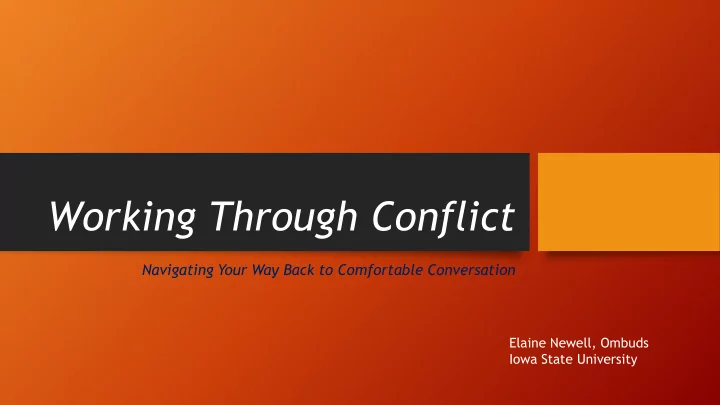

Working Through Conflict Navigating Your Way Back to Comfortable Conversation Elaine Newell, Ombuds Iowa State University
Today’s presentation: • Why conflict feels so stressful • How to handle difficult conversations • Resources • Q & A and B.Y .O.C.
Why Conflict Feels So Stressful
“Why are they doing that?” Understanding how your brain works can help you respond to conflict more effectively.
UNCERTAINTY = THREAT Conflict is full of uncertainty!
What is the workplace? Financial Endeavor Social Endeavor Vs.
When does the brain react in a survival mode: When it perceives threats: - Dinosaurs - Caveman with a club - Not being invited to lunch
SOCIAL CONNECTION = SURVIVAL The brain connects “social” with “survival”: being ostracized and being hungry activate similar negative neural responses.
It’s also about communication styles. “Impersonal” “Personal” • Direct • Indirect • Linear • Circular • Intellectual engagement • Relational engagement • Detatched • Attached • Concrete • Abstract
So what does this all mean? • It’s not about you. • It’s about your brain . . . and theirs. • It’s about your communication style . . . and theirs
How to Handle Difficult Conversations (with reasonable people)
Do not use email!
“You can have steps, a model, a game plan you think you’ll be working from, but after the first ten minutes, the bull’s going to leave the chute and you just need to hang on.” Plan ahead, then prepare to just hang on.
“What do I say?” • Plan your opening & your objective. • Focus on the problem – not the person. • Start from the middle. • Ask for their perspective, opinions, ideas. • Explain relevant history. • Reveal how you feel. • Admit your contribution to the problem. • Point out what you share.
Can you de-personalize the issue? • “ Y ou’re not pulling your • “I’d like to get your weight on the committee. thoughts on how we can try and divvy up equitable workloads for everyone on the committee.”
Conversation Starters & Stoppers • “Do you have some time to • “I need to talk to you.” share your thoughts?” • “Can you get to the point?” • “Help me understand…” • “Don’t you get it?” • “It sounds like that’s • “What’s the big deal?” important to you…” • “I don’t care what you think!” • “What do you think?” • “You’re crazy!” • “I see this from a different perspective.”
THE BIG EVENT • Your goal: Conversation, not confrontation. • MAKE IT SAFE! • Listen, listen, listen some more. • Inquire → acknowledge → empathize. • Be prepared for ebb and flow. • Share problem solving. • Decide together what’s next.
BE PREPARED Anger/Defensiveness Tears • Hand them a tissue. • Can be productive (“Help me • “Would you like a few minutes of understand why you feel that privacy?” way.”) • “I’m sorry … this is painful to talk • No need to respond to about.” everything they say. • Would it be easier if we met later?” • It’s okay to draw the line. • Invite questions. • Remind them of alternatives. • Consider your timing.
How to Handle Difficult Conversations (with difficult people)
What I think about your intentions will affect “ how I think about you, and ultimately, how our conversation goes. The error we make in the realm of intentions is simple but profound: we assume we know the intentions of others when we don’t . Worse still, when we are unsure about ” someone’s intentions, we too often decide they are bad. Difficult Conversations, by Douglas Stone, Bruce Patton, Sheila Heen Don’t make assumptions!
“Never attribute to malice that which is adequately explained by stupidity.” Robert Hanlon
What can you do? • Recognize (and fight) your own preconceptions • During the conversation: • What bothers you about him/her? • Give credit where credit is due • Combine candor with grace • Ask him/her to share in problem-solving • If all else fails, let it go.
Unexpected difficult conversations in a very public place • Same principles apply. • Set boundaries. • Make it a big conversation. • Identify/reject bad behavior. • Help people save face.
To avoid conflict: stop the gossip. Gossip: Comments made about others who aren’t present to correct the information presented or defend/explain themselves.
Best Practices • Don’t avoid dealing with the problem. • Plan, plan, plan some more -- and then just hang on. • Do make it a conversation (& not a debate). • Do make it safe. • Don’t make assumptions. • Don’t pass judgment. • Don’t gossip.
Resources on Conflict Management • Mediation training (Iowa Mediation Service) • Ombuds Office Resource Guide • Parks Library • Difficult Conversations by Douglas Stone, et. al. • Crucial Conversations, by Kerry Patterson , et. al. • Research articles -- I’m happy to share links & citations
Any Questions? Anyone Care to share?
Recommend
More recommend